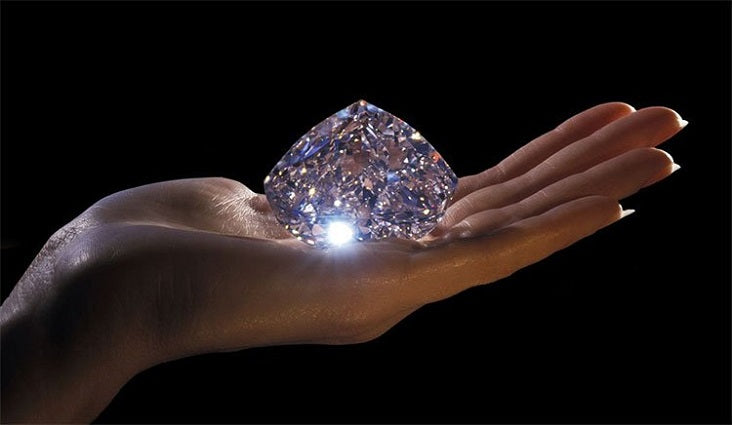Diamond is a mineral with perfect physical properties, existing in one of two variations of Carbon. So how can you choose a good diamond? Together C Jewelry Diamond Find out these knowledge of choosing the best diamond in the article below!
Review the formation process
Diamonds begin to form in places with very high temperatures and pressures, specifically a depth of about 150 km (compared to the ground), a pressure of 5 gigapascals, a temperature of 1200 degrees Celsius. Just enough to meet these requirements. With the above conditions, diamonds can be found anywhere.

However, the largest amount of mining today is in Central Africa and South Africa (accounting for about 49%), followed by Canada, India, Russia, Brazil, Australia, etc. The place where many diamonds are found is in volcanic craters. off, deep inside the Earth.
The reason is that the crater has high pressure and temperature, enough to change the structure of crystals in the ground. It usually takes about 1 billion to 3.5 billion years for a diamond to form naturally.
SEE MORE : Diamond ring case
Knowledge of choosing the best diamond
Diamonds or diamond jewelry are high-end products. But not every customer knows how to choose a suitable diamond or diamond jewelry. Here are some tips for your reference.
- The diamond sets the 4C standard
A diamond is evaluated according to a 4C quality system: “carat” (mass), “clarity” (transparency), “color” (color) and “cut” (cut).
Weight: Carat is the unit of weight of a diamond, 1 Carat = 200 milligrams. The larger the diamond, the greater its value. For example, 2 diamonds weighing a total of 2 Carat have a lower selling price than 1 diamond weighing 2 Carat.
Transparency: The transparency of a diamond is evaluated by scratches, fractures, etc. when viewed under a magnifying glass 10 times. Because scratches, breaks, etc. can affect the properties of the crystal and reduce the ability to refract light.

Color: The most common impurities are nitrogen, which mixes with the diamond crystals and gives the diamonds a yellow or even brown color. Almost all diamonds have color, more or less, because nothing is perfect. According to GIA (Gemological Institute of America) standards, colorless diamonds are "D" and yellow diamonds are "Z".
Cut: Crafting quality reflects the process of crafting the diamond from its original rough form into a finished diamond. If not beautifully crafted, the value of the diamond can be greatly reduced.
EXPLORE MORE : Why are larger diamonds more difficult to value ?
- Inspection certificate
Diamond testing is an option to determine the properties and value of each diamond used on the market. This contributes to the products having accurate value and not being counterfeited.
There are 4 organizations capable of evaluating the quality of a diamond:
GIA (Gemological Institute of America): Most prestigious, influential and the place that sets standards for the diamond industry.

AGS (American Gemological Society): Influential but not to the same extent as GIA.
IGL (World Gem Laboratory): The most respected place in the scientific world but also a place that is widely criticized for its unfairness when evaluating diamonds in poor countries.
EGL (European Gem Laboratory): Similar to IGL.
- Identify real diamonds
+ Look at a diamond under a magnifying glass: diamonds are made from nature and are composed of pure carbon, so when looking at it, it will not be difficult to see that it always has imperfections in the carbon structure. . Fake diamonds are absolutely perfect, flawless.
+ Rub sandpaper on the stone: Diamond is one of the hardest materials so it will not be easily scratched by rough or uneven surfaces. “If it is a real diamond, it will still be perfect after being sanded, but if it is Zirconia (imitation diamond jewelry), it will be scratched.”
+ Do the "fog experiment": Breathe into the diamond the same way you "fog" a bathroom mirror. Fake diamonds will fade on the surface in a short period of time, while real diamonds do not retain heat so they do not fade.
+ Look at the diamond under light to check its sparkle: The way real diamonds reflect under light is extremely unique: on the inside the diamond will sparkle gray and white, on the outside it will reflect rainbow colors onto other surfaces near it.
+ Observe the light refraction of the stone: Diamonds have sparkling colors thanks to the properties of refraction and bending of light. Glass, quartz and Cubic Zirconium can also "imitate" the sparkle of diamonds, but they have a much lower refractive index than diamonds.
Above is the knowledge to help you choose the best diamond. Hopefully, you have had more useful information for you

